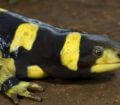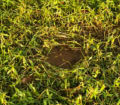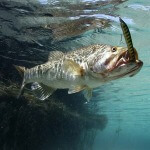Editor’s Note: For years, the secret was kept primarily in the Southeast. Those good ole boys living along the Appalachian chain of mountains, who were accustomed to catching live bait and using that bait to take bass, rarely shared their secret. Most folks knew that crayfish, night crawlers and minnows would catch bass, and that occasionally a bigmouth could be caught on a frog or a mouse. But the men from the hills discovered that the best bait for bucketmouths were amphibians known as spring lizards and waterdogs – two different kinds of salamanders. The spring lizard and the larvae of the tiger salamander, which are called waterdogs, are best for bass. Cold-blooded, salamanders become more active when temperatures are cooler – just the opposite of most live bait. In an aquarium test, bass ignored minnows, frogs and worms to grab the long-lasting and active waterdogs and spring lizards.
 If you can’t find live salamanders to fish for bass, the rubber salamander is an excellent substitute. And, there are many techniques that have been and are being developed to fish this rubber lizard. Here’s what a Kentucky fisherman, who’s been angling a rubber salamander for many years, told me. “In the early spring before the bass go on the bed and even after they have gone on the bed, the black rubber lizard is hard to beat. The spring lizard is a natural enemy of the bass and the natural food of the bass. When that rubber lizard gets close to the bass’s nest, or where the bass is trying to build a nest, the bass just has to attack. One of the best ways to fish the rubber salamander is to rig it Texas style, like you would a worm, use a 3/16-ounce sinker and cast it out past where you believe the bass are trying to bed. Retrieve the lure to the bedding area, and let it fall into the bed. Then wait.
If you can’t find live salamanders to fish for bass, the rubber salamander is an excellent substitute. And, there are many techniques that have been and are being developed to fish this rubber lizard. Here’s what a Kentucky fisherman, who’s been angling a rubber salamander for many years, told me. “In the early spring before the bass go on the bed and even after they have gone on the bed, the black rubber lizard is hard to beat. The spring lizard is a natural enemy of the bass and the natural food of the bass. When that rubber lizard gets close to the bass’s nest, or where the bass is trying to build a nest, the bass just has to attack. One of the best ways to fish the rubber salamander is to rig it Texas style, like you would a worm, use a 3/16-ounce sinker and cast it out past where you believe the bass are trying to bed. Retrieve the lure to the bedding area, and let it fall into the bed. Then wait.
“When the bass picks the bait up, don’t strike the rubber salamander immediately like you do when you’re fishing a worm. Let the bass take the lure, and mouth it. In the early spring, I generally let the bass have the bait and move it for 4-6 feet. But from the first of May until June 15th, I may let the bass run as much as 10-12 feet before I try and set the hook. Most of the time I’ve found that if you don’t put any pressure on the bass, you can let the bass go anywhere it wants to before you set the hook.
“Oftentimes later in spawning season when the bass are on the nests, they will quickly take the rubber salamander and move it out of the nest. Then you won’t be able to catch them on the first cast. So, when this happens, I throw into the nest three or four times until I can finally stick the fish. However, I believe at certain times you aren’t going to catch that bass under any set of circumstances.”
 After the fish come off the bed, anglers generally flip rubber salamanders to the bass under schools of shad. A rubber salamander angler said, “There’s a few of us who started trying this technique a few years ago. It really has proven to be effective. When you get into the hot summer months – between the 1st and the 15th of July – many lakes start to go down. When this occurs, the bass will leave the bushes and will move out to deeper water. Usually within the next day or two, the shad will leave the shallow water and move out to the deep side of the bushes. These shad will hold there – I imagine waiting for the water to come back up, so they can then move in and feed on the algae and other small plant life close to the bank. These 3-foot-diameter schools will be made up of shad about 1- to 1-1/2 inches long, tightly schooled together and will look like a dark spot in the water. I believe that the bass stay under these schools to feed on the small shad and to use the school as cover to stay out of the sun.
After the fish come off the bed, anglers generally flip rubber salamanders to the bass under schools of shad. A rubber salamander angler said, “There’s a few of us who started trying this technique a few years ago. It really has proven to be effective. When you get into the hot summer months – between the 1st and the 15th of July – many lakes start to go down. When this occurs, the bass will leave the bushes and will move out to deeper water. Usually within the next day or two, the shad will leave the shallow water and move out to the deep side of the bushes. These shad will hold there – I imagine waiting for the water to come back up, so they can then move in and feed on the algae and other small plant life close to the bank. These 3-foot-diameter schools will be made up of shad about 1- to 1-1/2 inches long, tightly schooled together and will look like a dark spot in the water. I believe that the bass stay under these schools to feed on the small shad and to use the school as cover to stay out of the sun.
“Anglers will cast rubber lizards right into the school and let them sink. This flipping seems to excite the school of shad and the bass that are swimming under the school. Most of the time the bass will take the bait as it falls through the school, before it hits the bottom. Always keep a tight line as the bait is falling, so you’ll know when the fish strikes the lure. Most of the time the bass we catch will only be 1-1/2 to 2-pound fish. But the action can be fun and exciting. I really enjoy fishing this way.”
However, the rubber salamander is not just a small bass bait. Anglers in the Panhandle of Florida utilize the plastic salamander to take trophy bass. As one told me, “In Florida, the bedding season often will begin in late February or early March. That’s when the big bass think the salamander is trying to eat their eggs. So, they will try and move the salamanders off the beds. Oftentimes the big bass will suck a bait in and then blow it out. They may not bite the bait, which means line watching is critical to catch a big bass. You have to be ready to set the hook the instant the line twitches. And sometimes two or three misses will occur before you catch the bass.
 “Oftentimes a female bass won’t pick up a salamander or just use her tail to brush it off the bed. When this happens, I simply cut a hole in the rubber salamander, break off a little bit of Alka Seltzer and place it in the hole. Then when I cast the salamander out, it gives off bubbles, and as those bubbles come out of the salamander, they seem to drive the ole bass crazy. I guess she thinks that the salamander is alive or is actually eating her eggs. But no matter what she thinks, she will attack much more aggressively and be easier to catch. If you can see the bass in the shallow water and get far enough away, so you can cast into the bed without spooking the fish, the bass seem to prefer the rubber salamander over any other bait I’ve ever fished.”
“Oftentimes a female bass won’t pick up a salamander or just use her tail to brush it off the bed. When this happens, I simply cut a hole in the rubber salamander, break off a little bit of Alka Seltzer and place it in the hole. Then when I cast the salamander out, it gives off bubbles, and as those bubbles come out of the salamander, they seem to drive the ole bass crazy. I guess she thinks that the salamander is alive or is actually eating her eggs. But no matter what she thinks, she will attack much more aggressively and be easier to catch. If you can see the bass in the shallow water and get far enough away, so you can cast into the bed without spooking the fish, the bass seem to prefer the rubber salamander over any other bait I’ve ever fished.”
 Whether you’re fishing a live salamander hooked through the lips and fished weedless, a plastic salamander flipped into the buck brush and bushes or a rubber salamander flipped into schooling shad and fished on bedding bass, the salamander pays big-bass dividends. The men who fish them still believe they are the most-deadly bass bait on the market.
Whether you’re fishing a live salamander hooked through the lips and fished weedless, a plastic salamander flipped into the buck brush and bushes or a rubber salamander flipped into schooling shad and fished on bedding bass, the salamander pays big-bass dividends. The men who fish them still believe they are the most-deadly bass bait on the market.
To learn more about bass fishing, check out John E. Phillips’ eBooks, print books and Audible books at https://johninthewild.com/books#bass.
















